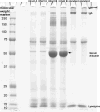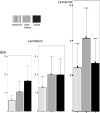Tear film volume and protein analysis in full-term newborn infants
- PMID: 21045650
- PMCID: PMC3650608
- DOI: 10.1097/ICO.0b013e3181f22cd9
Tear film volume and protein analysis in full-term newborn infants
Abstract
Purpose: To investigate infant tear film secretion and protein profile, and to compare major tear proteins, such as immunoglobulin A, lactoferrin, and lysozyme, with those of adult controls.
Methods: Tears were collected, with a cellulose rod, from 40 healthy infants (19 female infants and 21 male infants, gestational duration: 39.71 ± 1.27 weeks) within 48 hours of birth and 22 adults (10 female infants and 12 male infants, mean age: 24.95 ± 3.63 years). A second collection was obtained from 14 of the infants (8 female infants and 6 male infants, postnatal age: 7.76 ± 6.14 weeks). The tear volume was measured, and protein in the samples was analyzed by Bradford assay and gel electrophoresis.
Results: Median tear volume (interquartile range) was 0.5 μL (0.6-2 μL) for newborn infants, 2.5 μL (1.4-7.75 μL) for these infants at an older age, and 6 μL (2.73-12.75 μL) in adults (P < 0.001, Kruskall-Wallis test). Immunoglobulin A concentration was significantly lower in newborns (P < 0.001, analysis of variance). Lipocalin was present in 36% of the newborn tear samples, whereas serum albumin was found in 86%. Mean protein concentration (μg/μL ± SD) was 10.95 ± 5.51 in the newborns, 12.93 ± 3.99 in the older infants, and 13.04 ± 3.46 in the adults (P > 0.5, analysis of variance).
Conclusions: This is the first study reporting an investigation of unstimulated infant tears, using a noninvasive collection method. Tear protein content demonstrated that the infant tear film is different to that in adults.
Figures



Similar articles
-
Tear proteins of normal young Hong Kong Chinese.Graefes Arch Clin Exp Ophthalmol. 2000 Sep;238(9):738-45. doi: 10.1007/s004170000140. Graefes Arch Clin Exp Ophthalmol. 2000. PMID: 11045341
-
Method development for quantification of five tear proteins using selected reaction monitoring (SRM) mass spectrometry.Invest Ophthalmol Vis Sci. 2014 Feb 10;55(2):767-75. doi: 10.1167/iovs.13-12777. Invest Ophthalmol Vis Sci. 2014. PMID: 24408985
-
Analysis of tear proteins by one- and two-dimensional thin-layer iosoelectric focusing, sodium dodecyl sulfate electrophoresis and lectin blotting. Detection of a new component: cystatin C.Graefes Arch Clin Exp Ophthalmol. 1998 Dec;236(12):894-9. doi: 10.1007/s004170050177. Graefes Arch Clin Exp Ophthalmol. 1998. PMID: 9865619
-
A novel and innovative paper-based analytical device for assessing tear lactoferrin of dry eye patients.Ocul Surf. 2019 Jan;17(1):160-166. doi: 10.1016/j.jtos.2018.11.001. Epub 2018 Nov 3. Ocul Surf. 2019. PMID: 30399438 Review.
-
Tear analysis in contact lens wearers.Trans Am Ophthalmol Soc. 1985;83:501-45. Trans Am Ophthalmol Soc. 1985. PMID: 3914131 Free PMC article. Review.
Cited by
-
Optimizing instilled drug delivery: a scoping review of microdrops in ophthalmology.Graefes Arch Clin Exp Ophthalmol. 2025 Jul;263(7):1765-1787. doi: 10.1007/s00417-025-06773-1. Epub 2025 Feb 26. Graefes Arch Clin Exp Ophthalmol. 2025. PMID: 40011238 Free PMC article. Review.
-
Meibum lipid hydrocarbon chain branching and rheology after hematopoietic stem cell transplantation.Biochem Biophys Rep. 2020 Jul 20;23:100786. doi: 10.1016/j.bbrep.2020.100786. eCollection 2020 Sep. Biochem Biophys Rep. 2020. PMID: 32715105 Free PMC article.
-
Ophthalmia neonatorum as the presenting sign of SARS-CoV-2.J AAPOS. 2021 Aug;25(4):230-231. doi: 10.1016/j.jaapos.2021.03.001. Epub 2021 Mar 24. J AAPOS. 2021. PMID: 33774164 Free PMC article.
-
NanoLC-timsTOF-Assisted Analysis of Glycated Albumin in Diabetes-Affected Plasma and Tears.J Am Soc Mass Spectrom. 2024 Jan 3;35(1):106-113. doi: 10.1021/jasms.3c00331. Epub 2023 Nov 28. J Am Soc Mass Spectrom. 2024. PMID: 38016044 Free PMC article.
-
Tear protein analysis in presumed congenital alacrima.Clin Ophthalmol. 2018 Dec 11;12:2591-2595. doi: 10.2147/OPTH.S184207. eCollection 2018. Clin Ophthalmol. 2018. PMID: 30587905 Free PMC article.
References
-
- Sjogren H. The lacrimal secretion in newborn premature and fully developed children. Acta Ophthalmol (Copenh) 1955;33:557–560. - PubMed
-
- Apt L, Cullen BF. Newborns do secrete tears. JAMA. 1964;189:951–953. - PubMed
-
- Isenberg SJ, Del Signore M, Chen A, et al. The lipid layer and stability of the preocular tear film in newborns and infants. Ophthalmology. 2003;110:1408–1411. - PubMed
-
- Kaercher T, Mobius D, Welt R. Biophysical behaviour of the infant meibomian lipid layer. Int Ophthalmol. 1994;18:15–19. - PubMed
Publication types
MeSH terms
Substances
Grants and funding
LinkOut - more resources
Full Text Sources
Other Literature Sources
Medical
Miscellaneous

